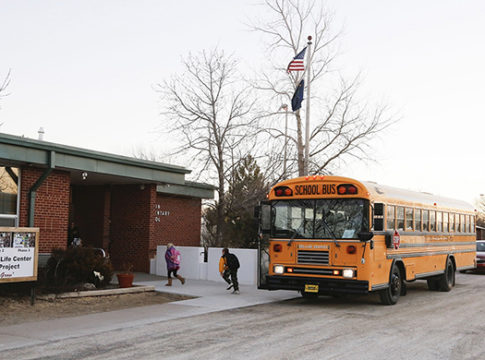
Paymon Rouhanifard has been the superintendent of Camden City Public Schools in New Jersey since 2013 when the district was put under state receivership. Camden still has a long way to go, but the changes thus far have been dramatic: graduation and proficiency rates have improved, and the majority of the city’s schools that were among the state’s lowest performing no longer are. Five years into his tenure, Rouhanifard announced that he will step down as Camden’s superintendent. CRPE founder Paul Hill recently sat down with Rouhanifard to reflect on his experience.
Building A Broad Coalition
Was your appointment as part of a state takeover a liability or an asset?
The state intervention guaranteed a degree of local skepticism, but we couldn’t have made the progress we did over these past five years without the change in governance.
You made a great deal of progress in Camden without causing a firestorm. How did you keep the community’s support?
There was certainly some pushback. But we also developed a broad coalition of support. We sought to improve existing public schools while transforming some neighborhood schools through nonprofit partnerships, which we call Renaissance Schools. To do these things we needed partnerships with nonprofits, both to support kids with wraparound services and operate some schools.
Everyone wanted to see improvement quickly, but it was clear that politics and bureaucracy had made reforms difficult in the past. Getting engagement from community leaders and nonprofits helped generate buy-in, making it clear that reforms were being done by, not to, Camden.
How did you grow the Renaissance Schools without putting a lot of incumbent teachers out of work and causing a community backlash?
For us, it was never about laying blame at the feet of educators. We guaranteed seniority status for teachers and withdrew protection only in a few extreme cases. We were always careful about teacher layoffs, understanding the financial damage they can do in a community with high unemployment.
We more or less grew Renaissance schools in line with natural teacher attrition, which was about 15 per year. We also did an early retirement incentive one year, when the growth of Renaissance Schools was at its highest.
A counter-reform narrative would pit national foundations against community, but you used foundation funding without a lot of political cost. How were you able to do that?
I had some luck. First, Camden is a smaller district so we did not get a lot of national attention. I am also careful about how I deal with foundations. I think they should fund something we deeply believe in. The minute we get into a dialogue about some other agenda item that may be useful but not central, we always examine it very closely.
Taking Multiple Paths
If you were to start in another district, would you do anything differently?
It all would depend on the district. In Camden, the case for change was so clear-cut. There were so many low-performing schools, financial problems, and mismanagement. Parents wanted something better.
Our theory of change (strengthen district schools and use new operators to turn around neighborhood schools) is good, but the balance would depend on the city’s needs and size. In Camden, we have no robust public transportation system, we have public safety issues, and many families don’t have cars. Here, families need to be able to walk kids to school, so we emphasized neighborhood schools. But if you go to New York City, you wouldn’t have to take that approach.
The Renaissance schools are a great invention. Do you think assignment to a charter operator is the only way to turn around a neighborhood school?
It is not the only way. Others have reached out to us asking how they can replicate the Renaissance model. I don’t think that’s the right question. Every municipality is different—the needs, the constituents, the public officials, the willingness of quality charter operators to work in the neighborhood context. I think Renaissance and other turnaround models can provide quick results. But you also need to play the long game, and that involves taking multiple paths.
Charter schools were a big part of your strategy. But did you get pressure to use them even more?
We were very clear with charter/Renaissance operators: We have big problems that can’t be solved quickly. Charters had to learn how to succeed in our context; they could grow to the extent that they were succeeding. I also made it clear that they would be running the schools that faced the greatest challenges.
My optimism about charters is that they can improve over time as they gain experience working in a high-poverty context. Their value is not in union-busting or bypassing collective bargaining, but in serving kids better. We brought in KIPP, Uncommon, and Mastery, all of whom were committed to working as part of our larger strategy.
What did you do for the district schools that were not part of the Renaissance strategy?
Within traditional schools, we used Camden PLUS and Relay to train local leaders and teachers. We also created new positions in all district schools—family-focused staff and teachers devoted to social and emotional learning. We would like to go even further toward a wraparound model by developing mental health clinics. Our results within traditional public schools steadily improved over five years.
We at CRPE are trying to think ahead about personalization. District-run schools have a hard time implementing changes. How can we prepare the district for more innovation?
I favor personalization, but remain skeptical of technology-driven innovation as a primary solution, especially in low-income communities. Our students need relationships with adults to address social-emotional challenges. They need mentorship and secure attachments. That said, Summit really stands out to me because of how it marries technology with the role of adults. We have their personalized learning platform in a two-school pilot and are considering whether to expand it further.
You said that we need to take the long game in education. What do you mean by that?
It means two things. First, that it takes time to reform a city’s schools because everybody, including the best charter operators, needs to ask what’s working and what’s not, apply lessons learned, look for new ideas, and iterate. And when I say time, I don’t mean 3 to 5 years, but 10 to 20 years.
Second, a lot of the work we do won’t show up in state assessments. Camden needs kids to learn more in school, but also to get further education and training, to get good jobs to support themselves and their families, and to become engaged community members. Test scores tell us very little about the long-term outcomes that really matter.
Measuring What We Value
Would you get rid of tests?
Believe me, I am not anti-testing. But I do think the state tests take too much time and get too much attention. Great educators know that time spent on practice tests or interims is time not spent on rigorous instruction.
I think we spend so much time testing just two subjects, English Language Arts and math, but we also have a different problem of not having enough tests. You measure what you value, and we’re not placing enough value on other subjects, like sciences and the arts. For example, the only science test in New Jersey is biology, so you are implicitly sending the message that chemistry and physics don’t matter.
In my mind, we should have a variety of short, formative assessments and only a few, longer high-stakes tests. When it comes to government assigning stakes, testing should measure the progress of systems, not schools or teachers or students. There’s just too much noise in the data at the micro level, making it very challenging to assign stakes to the results. NAEP already exists, and it is a great measuring stick for systems.
What is next for you?
I am starting off with a fellowship. I want to know how K–12 systems, higher education, employers, and the state can work together to create a pipeline of jobs for a regional economy. I’m excited to continue to work on behalf of kids from low-income communities.
— Paul Hill
Paul T. Hill is Founder of the Center on Reinventing Public Education and Research Professor at the University of Washington Bothell.
This post originally appeared on The Lens.




